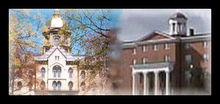 One of my former classmates posted this recollection of one of our most outstanding and memorable classes. I have to share. The story and message have stayed with many of us from that class, and the telling is still vivid in my mind.
One of my former classmates posted this recollection of one of our most outstanding and memorable classes. I have to share. The story and message have stayed with many of us from that class, and the telling is still vivid in my mind.A philosophy professor of mine once told a story from when he was an undergraduate* at Notre Dame. He would routinely go to pray at the Grotto (a replica of the one at Lourdes) and began to notice that the leaves surrounding the statue of Mary would turn a golden hue before any of the others showed a hint of their autumn shades. This, of course, was halfheartedly rumored to be a miracle among many of the more pious students; just as the Grotto at Lourdes was the home of a famous miracle. As it turns out, there was a perfectly rational explanation for such a phenomenon: because of the particular formation of the surrounding trees, it just so happened that the leaves around Mary's statue were exposed to more direct sunlight each day than those in the adjacent areas (or something like that). Not much of a miracle in the end.*I'm pretty sure it was during his graduate years.
However, as my professor pointed out, we should in fact be more astonished because of the non-miraculous nature of the phenomenon. That God was able to achieve such a "fitting" spectacle through the precise arrangement of countless natural, secondary causes makes for a more beautiful symphony. The conductor is far more impressive when a wave of his hand sets all of the other musicians in motion as a perfect and harmonious collaboration; than if he were to leave his stand, commandeer one of the instruments, and play a solo piece that drowned out the music of the orchestra.
The perfect photo taken from another Irish Blog









2 comments:
Dr. O'Callaghan! I remember that story from my Aquinas class with him.
Wasn't that an awesome class?
Post a Comment